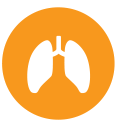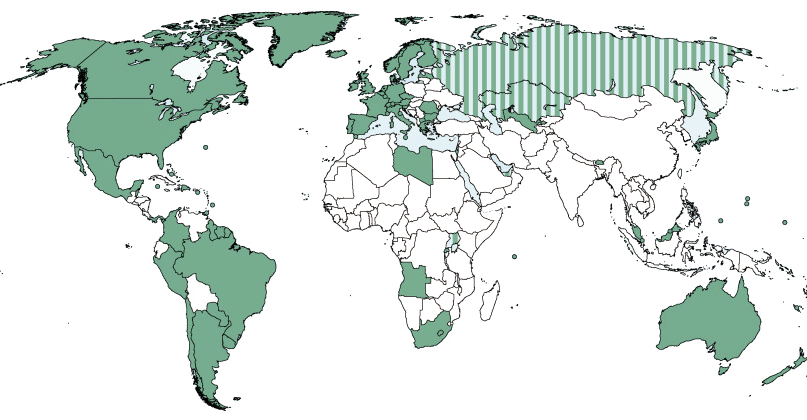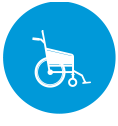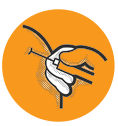.firstcharacter
{ float: left; color:#333333; font-size: 3.4em; line-height: 50px; padding-top: 4px; padding-right: 1px; padding-left: 33px; font-weight:400; }
.source {
width:500px;
font-size:15px;
line-height:22px;
color:#903;
}
If all the countries are to reach at least 90 per cent coverage for routine life-saving vaccinations, 9.9 million additional children would need to be vaccinated in 64 countries.
Three in four of these children live in fragile countries, including those which are affected by conflict; 4 out of 10 live in the three countries that are yet to prevent polio transmission—Nigeria, Afghanistan and Pakistan.
 Did you know? Out of the 8 countries that had DTP3 coverage of less than 50 per cent in 2016, six are in Africa
Did you know? Out of the 8 countries that had DTP3 coverage of less than 50 per cent in 2016, six are in Africa
How Many Children Didn't Receive The DTP Vaccine?
Since 2010, the percentage of children who received their full course of routine immunisation has stalled at 86 per cent
☛ Data source: Analysis of WHO vaccination data and United Nations population estimates, 2016
Immunization averts an estimated 2 to 3 million deaths every year from diphtheria, tetanus, pertussis (whooping cough), and measles; however, an additional 1.5 million deaths could be avoided if global vaccination coverage improves. Global vaccination coverage – the proportion of the world’s children who receive recommended vaccines – has stalled over the past few years.
A summary of global vaccination coverage in 2016 follows.
Haemophilus influenzae type b (Hib)
 72 per cent 72 per cent
Global coverage
Haemophilus influenzae type b (Hib) causes meningitis and pneumonia. Hib vaccine had been introduced in 191 countries by the end of 2016. Global coverage with 3 doses of Hib vaccine is estimated at 70 per cent. There is great variation between regions. In the WHO Region of the Americas, coverage is estimated at 90 per cent, while it is only 28 per cent in the WHO Western Pacific Region. The WHO South-East Asia Region raised coverage from 56 per cent in 2015 to 80 per cent in 2016.
|
☛ Data source: Immunization coverage Fact sheet, July 2017, WHO & UNICEF
|
Hepatitis B
☛ Data source: Immunization coverage Fact sheet, July 2017, WHO & UNICEF
|
 39 per cent 39 per cent
Global coverage
Hepatitis B is a viral infection that attacks the liver. Hepatitis B vaccine for infants had been introduced nationwide in 186 countries by the end of 2016. Global coverage with 3 doses of hepatitis B vaccine is estimated at 84 per cent and is as high as 92 per cent in the Western Pacific. In addition, 101 countries introduced one dose of hepatitis B vaccine to newborns within the first 24 hours of life
|
Human papillomavirus
 vaccine was introduced in vaccine was introduced in
74 Nations
 Human papillomavirus is the most common viral infection of the reproductive tract, and can cause cervical cancer, other types of cancer, and genital warts in both men and women. Human papillomavirus vaccine was introduced in 74 countries by the end of 2016, including four countries with introduction in some parts of the country. Human papillomavirus is the most common viral infection of the reproductive tract, and can cause cervical cancer, other types of cancer, and genital warts in both men and women. Human papillomavirus vaccine was introduced in 74 countries by the end of 2016, including four countries with introduction in some parts of the country.
☛ Data source: Global estimates of human papillomavirus vaccinationome level: a pooled analysis, Lancet, July 2016
|
Measles
 Did you know? South-east Asia, reported cases of measles jumped from 30,101 in 2013 to 82,006 in 2016
Did you know? South-east Asia, reported cases of measles jumped from 30,101 in 2013 to 82,006 in 2016
☛ Data source: Immunization coverage Fact sheet, July 2017, WHO & UNICEF
|
 64 per cent 64 per cent
Global coverage
Measles is a highly contagious disease caused by a virus, which usually results in a high fever and rash, and can lead to blindness, encephalitis or death. By the end of 2016, 85 per cent of children had received one dose of measles vaccine by their second birthday, and 164 countries had included a second dose as part of routine immunisation and 64 per cent of children received two doses of measles vaccine according to national immunisation schedules.
|
Meningitis A
 260 million 260 million
people affected in Africa
Meningitis A is an infection that can cause severe brain damage and is often deadly. By the end of 2016 – 6 years after its introduction – more than 260 million people in African countries affected by the disease had been vaccinated with MenAfriVac, a vaccine developed by WHO and PATH. Ghana and Sudan were the first two countries to include the MenAfriVac in their routine immunisation schedule in 2016.
|
☛ Data source: Immunization coverage Fact sheet, July 2017, WHO & UNICEF
|
Mumps
 Did you know? As opposed to 38,713 reported cases of mumps in 2000, Africa saw more than 250 per cent rise in 2016 with 100,576
Did you know? As opposed to 38,713 reported cases of mumps in 2000, Africa saw more than 250 per cent rise in 2016 with 100,576
☛ Data source: Immunization coverage Fact sheet, July 2017, WHO & UNICEF
|
 vaccine was introduced in vaccine was introduced in
121 Nations
Mumps is a highly contagious virus that causes painful swelling at the side of the face under the ears (the parotid glands), fever, headache and muscle aches. It can lead to viral meningitis. Mumps vaccine had been introduced nationwide in 121 countries by the end of 2016.
|
Pneumococcal diseases
>
 vaccine was introduced in vaccine was introduced in
134 Nations
Pneumococcal diseases include pneumonia, meningitis and febrile bacteraemia, as well as otitis media, sinusitis and bronchitis. Pneumococcal vaccine had been introduced in 134 countries by the end of 2016, including three in some parts of the country,
|
☛ Data source: Immunization coverage Fact sheet, July 2017, WHO & UNICEF
|
Polio
☛ Data source: Immunization coverage Fact sheet, July 2017, WHO & UNICEF
|
 85 per cent 85 per cent
Global coverage
Polio is a highly infectious viral disease that can cause irreversible paralysis. In 2016, 85 per cent of infants around the world received three doses of polio vaccine. Targeted for global eradication, polio has been stopped in all countries except for Afghanistan, Pakistan and Nigeria. Polio-free countries have been infected by imported virus, and all countries – especially those experiencing conflict and instability – remain at risk until polio is fully eradicated.
|
Rotaviruses
 25 per cent 25 per cent
Global coverage
Rotaviruses are the most common cause of severe diarrhoeal disease in young children throughout the world. Rotavirus vaccine was introduced in 90 countries by the end of 2016, including six in some parts of the country
|
☛ Data source: Immunization coverage Fact sheet, July 2017, WHO & UNICEF
|
Rubella
☛ Data source: Immunization coverage Fact sheet, July 2017, WHO & UNICEF
|
 47 per cent 47 per cent
Global coverage
Rubella is a viral disease which is usually mild in children, but infection during early pregnancy may cause fetal death or congenital rubella syndrome, which can lead to defects of the brain, heart, eyes, and ears. Rubella vaccine was introduced nationwide in 152 countries by the end of 2016
|
Tetanus
 84 per cent 84 per cent
Global coverage
Tetanus is caused by a bacterium which grows in the absence of oxygen, for example in dirty wounds or in the umbilical cord if it is not kept clean. The spores of C. tetani are present in the environment irrespective of geographical location. It produces a toxin which can cause serious complications or death. The vaccine to prevent maternal and neonatal tetanus had been introduced in 106 countries by the end of 2016. An estimated 84 per cent of newborns were protected through immunisation. Maternal and neonatal tetanus persist as public health problems in 18 countries, mainly in Africa and Asia.
|
☛ Data source: Immunization coverage Fact sheet, July 2017, WHO & UNICEF
|
Yellow fever
☛ Data source: Immunization coverage Fact sheet, July 2017, WHO & UNICEF
|
 45 per cent 45 per cent
Global coverage
Yellow fever is an acute viral haemorrhagic disease transmitted by infected mosquitoes. As of 2016, yellow fever vaccine had been introduced in routine infant immunisation programmes in 35 of the 42 countries and territories at risk for yellow fever in Africa and the Americas. In these 42 countries and territories
|
In India
 Immunisation coverage continues to be low despite decades of publicly financed universal immunisation programme. Between 2005-06 and 2015-16, immunisation coverage increased from 44 to 62 per cent, but much of the progress comes from rural areas (from 39 to 61 per cent). Strangely, urban areas witness very low improvements (from 58 to 64 per cent). Immunisation coverage continues to be low despite decades of publicly financed universal immunisation programme. Between 2005-06 and 2015-16, immunisation coverage increased from 44 to 62 per cent, but much of the progress comes from rural areas (from 39 to 61 per cent). Strangely, urban areas witness very low improvements (from 58 to 64 per cent).
If India has to meet the SDG commitment of universal immunisation coverage by 2030, it has to bridge the gap of 38 per cent. It means, every year it has to ensure full immunisation of about 27 million new born.
|
 |
| |

The coloured dots in this punchcard show WHO and UNICEF Estimates of National immunisation Coverage, (data as of July 15, 2016) for all universally recommended vaccines for which these estimates are available.
☛ Data source: World Health Organisation, July 2017
|
Putting vaccination back on the agenda
 Middle-income countries are lagging behind in the introduction of more recently recommended vaccines such as rotavirus and pneumococcal conjugated vaccine as they may not receive external support and their health budgets are currently insufficient to cover the costs of these vaccines.
Middle-income countries are lagging behind in the introduction of more recently recommended vaccines such as rotavirus and pneumococcal conjugated vaccine as they may not receive external support and their health budgets are currently insufficient to cover the costs of these vaccines.
These vaccines have the potential significantly to reduce pneumonia and diarrhoea—the top two causes of death in children under 5 in the world. Before that, the health ministers in developing countries have to put DTP vaccine back on their agenda.
Data source:
✿ World Health Organisation (WHO)
✿ United Nations International Children's Emergency Fund (UNICEF)
✿ World Bank
✿ The Lancet

BACK TO TOP
 Did you know? Out of the 8 countries that had DTP3 coverage of less than 50 per cent in 2016, six are in Africa
Did you know? Out of the 8 countries that had DTP3 coverage of less than 50 per cent in 2016, six are in Africa Did you know? Out of the 8 countries that had DTP3 coverage of less than 50 per cent in 2016, six are in Africa
Did you know? Out of the 8 countries that had DTP3 coverage of less than 50 per cent in 2016, six are in Africa Did you know? South-east Asia, reported cases of measles jumped from 30,101 in 2013 to 82,006 in 2016
Did you know? South-east Asia, reported cases of measles jumped from 30,101 in 2013 to 82,006 in 2016 Did you know? As opposed to 38,713 reported cases of mumps in 2000, Africa saw more than 250 per cent rise in 2016 with 100,576
Did you know? As opposed to 38,713 reported cases of mumps in 2000, Africa saw more than 250 per cent rise in 2016 with 100,576 

 Middle-income countries are lagging behind in the introduction of more recently recommended vaccines such as rotavirus and pneumococcal conjugated vaccine as they may not receive external support and their health budgets are currently insufficient to cover the costs of these vaccines.
Middle-income countries are lagging behind in the introduction of more recently recommended vaccines such as rotavirus and pneumococcal conjugated vaccine as they may not receive external support and their health budgets are currently insufficient to cover the costs of these vaccines.